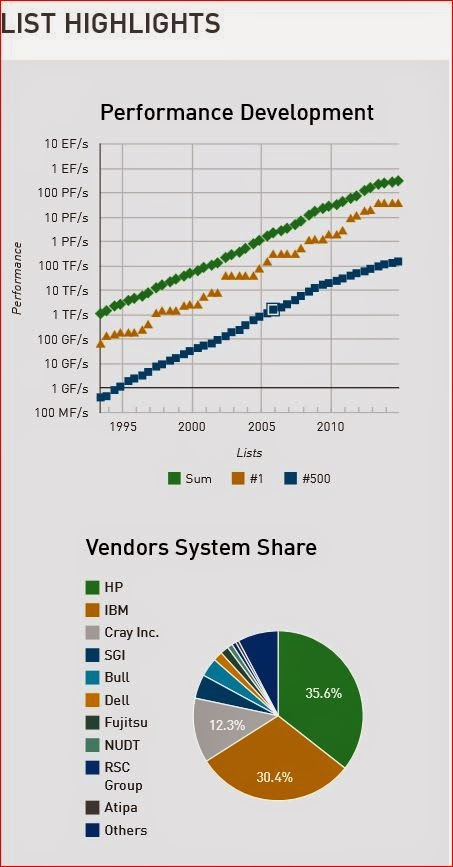The memorable talk of Dr. Horst Simon at HPC San Francisco Meetup.
On February 10, 2015, Dr. Horst Simon spoke at the San Francisco High Performance Computing Meetup. His presentation video, Usable Exascale and Beyond Moore's Law is embedded below.
This video is viral. I see it already on LinkedIn (including Horst page), on HPCwire. How come the "penniless" HPC Meetup in San Francisco managed to produce a professional video?
This video is viral. I see it already on LinkedIn (including Horst page), on HPCwire. How come the "penniless" HPC Meetup in San Francisco managed to produce a professional video?
What is so special about it? Dr. Simon is one of the biggest names in supercomputing, a star for events like SC15 and ISC High Performance 2015. He is one the founders of the TOP500 list. It ranks the most powerful computers in the world in terms of floating point operations per second.
 |
| Screen shot from top500.org home page |
While I introduced the speaker to the meetup audience, I asked two questions:
- How many of you heard of Dr. Simon before?
- How many of you heard of TOP500 before?
The meetup audience in San Francisco, made up not from researchers in government, but hpc adventurers looking for inspiration to create new businesses based on HPC or simply getting some decent paying jobs with organizations that make money and can afford to pay for knowledge. His presentation made the audience feel "clever", he had zero aloofness typical of some haughty professors and charming, engaging, honest style in sharing what he knows and what he doesn't equally.
You will watch the presentation and make your own opinions.
Horst is not talking of exabytes in storage. The entire world storage capacity is estimated as 1,200 exabytes in 2014. Horst is talking of a supercomputer capable to process one exaflops (flop is from floating point operations per second ) as peak performance. Here is the mind boggling exaflop definition:
one exa floating point operations per seconds = 1 000 000 000 000 000 000 flops = 1 000 petaflops = 1 million teraflops = 1 billion gigaflops
He made a bet of two thousands dollars with Thomas Lippert, - the director of the Julich Supercomputing Center in Germany - that Exabyte computer using CMOS technology will NOT exist before 2020..
The TOP500 data shows clearly we are approaching the end of an era. The Moore Law will no longer be applicable. But two new technologies, 3D integrated circuits and silicon photonics will create more flops per units of power consumption and will delay the end of the Moore Law. However, in Dr. Simon's opinion,- this will not happen sooner than 2020.
I like the exoticism of such a term: "non-von Neumann" architecture. But what it means is that the original architecture devised in 1952 by John von Neumann (his real name is Neumann János Lajos) and Julius Robert Oppenheimer, in order to solve physics problems, is still valid today and it used by every enterprise, cloud computing and social network data center. This is where Moore's Law applies
What if Peter Thiel and Elon Musk were attending this meetup?
They were not, But I like to think that some future entrepreneurs were sitting in this meetup who will be as famous as Peter and Elon. And they reach fame, they can give Horst the credit of mentoring them.
Here are two ideas that fit the "zero-to-one" companies as described in by Peter Thiel.book with the same title.
A brain computer
It is possible to built a supercomputer that will have the same power to process as the human brain, Such computer will have between 1 to 10 exaflops and 4 petabytes of memory. It will consume 20 to 30 megawats of power which is one million times more than the brain itself. Such a computer will not reach consciousness, but will process the electrical signals of the brain with the same speed.Peter Thiel co-founded Palantir one of the most successful big data companies in the world. Following Oppenheimer and von Neumann advise, - the architecture must follow the applications being run - such a hardware can complement what Palantir does. The idea of the Brain Computer is not new and there are about six projects in the world trying to implement it. But what is new, - blame me for that - is the association with Palantir. To make a hardware specially for their super-secret applications that one day will benefit the rest of us.
Time magazine today has a cover story with a cute baby, that says: This baby could live to be be 142 years old." If this prophecy turns true, is because the Brain Computer will be built.
A formidable face recognition system
The IBM SyNAPSE project lead by D. Modha is part of the cognitive computingIBM built a new chip with a brain-inspired computer architecture powered by an unprecedented 1 million neurons and 256 million synapses. It is the largest chip IBM has ever built at 5.4 billion transistors, and has an on-chip network of 4,096 neurosynaptic cores. Yet, it only consumes 70mW during real-time operation — orders of magnitude less energy than traditional chips.
 |
| IBM Brain Infographic |
Horst gave us an idea. What a cell phone based this technology able to google every face and tell you everything about that person. Horst gave as example of going to a conference, someone salutes you, you salute but you don't have a clue of who this person might be.
I go a bit further and I imagine someone going to a party and the phone identifies the third husband of his wife. But all the defense organizations and intelligence agencies in the world will have a much richer imagination

Comments